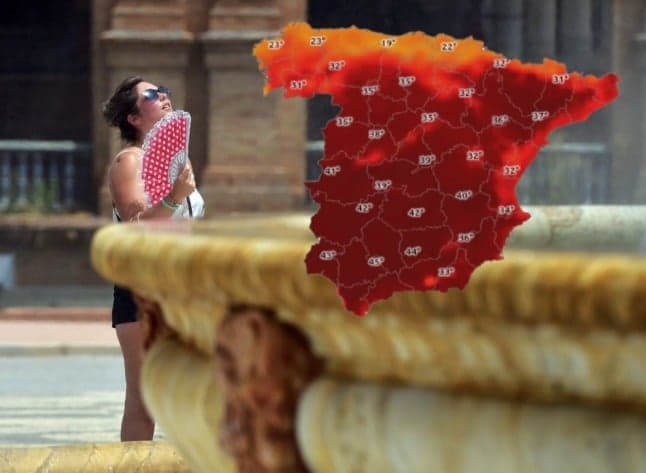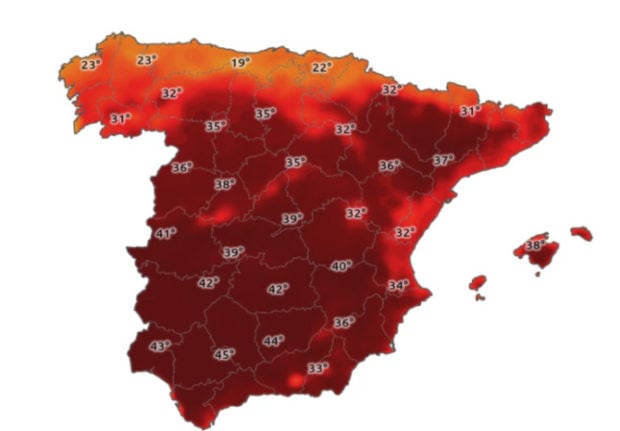Spain set to stifle in first official heatwave of the summer

Spain’s national weather agency has warned that a period of extreme and prolonged heat is set to reach the country on Wednesday, bringing with it temperatures above 35C to most regions and very little wind.
"Mainland Spain and the Balearic Islands are facing a probable heatwave, with very high temperatures during the day and at night, which will begin in a general and progressive way by Wednesday August 11th and will last at least until Monday 16th or Tuesday 17th,” Aemet spokesperson Rubén Campo said on Monday.
“This could lead to adverse effects on people's health and to a significant risk of forest fires.”
Temperatures are expected to exceed 40C in some areas of central and southern Spain by Wednesday, with values above 35C in the surrounding area and in the Balearic Islands.
Una #OlaDeCalor afectará a España durante los próximos días. Será un episodio intenso, extenso y duradero, con temperaturas muy altas tanto de día como de noche. Conviene extremar la precaución: la situación será adversa. Te contamos más en este #VídeoAEMET pic.twitter.com/zeDjPck3Ud
— AEMET (@AEMET_Esp) August 9, 2021
On Thursday August 12th, daytime temperatures are expected to rise above 40C across all of central and southern Spain, and nighttime minimums will be higher than 22C.
By the weekend, temperatures will also be in the mid to high thirties in parts of the Basque Country, Castilla and León, Catalonia and Aragón.

Map displaying temperatures across Spain on Saturday August 14th, according to Aemet's forecast.
Galicia, the Canary Islands as well as parts of Asturias and Cantabria are the only places that aren’t forecast to be affected by the extreme heat, although the high temperatures could reach the archipelago by the weekend.
Casi todo el Mediterráneo será afectado esta semana por intensa #OlaDeCalor🔥con Temperaturas >6°C sobre típicos👇Malas noticias especialmente para Grecia, afectada por voraces #IncendiosForestales🔥; Atenas podría superar los 38°C varios días esta semana. https://t.co/SYZp4SR5cb pic.twitter.com/5y30I4bM9y
— Antarctica.cl (@Antarcticacl) August 8, 2021
Even though there have been periods of extreme heat this summer, in order for it to be classified as a heatwave by Aemet, three conditions must be met: the weather episode of high temperatures has to be intense, it has to affect most of Spain and it has to be long-lasting.
The cause of Spain’s first heatwave of the year is a mass of hot air that’s approaching from North Africa and the central Mediterranean which will stabilise the atmosphere, resulting in intense sun and no wind to clear the warm air.
The extreme heat episode will be accompanied by very low relative humidity during the day and night.
There will also be dust in suspension blown over from the Sahara desert - known as calima in Spain - which will contribute to the sensation that the air is extremely dry and suffocating.
Presencia de #polvosahariano en la Península y las
islas Baleares para estos días. @Dust_Barcelona https://t.co/o8bbgcWMZr
Recuerda que el calor y la contaminación agravan sus efectos en la salud.
Nos lo contaba @ensgismau en #AEMETblog >>https://t.co/yNVPBL6uh4 pic.twitter.com/M8nPFVlVlJ
— AEMET (@AEMET_Esp) August 9, 2021
As this year has been very dry due to the lack of rainfall the risk of forest fires will increase during this heatwave, as the following map by Aemet illustrates.
#PredicciónAEMET. Nivel de riesgo de incendios previsto hoy y mañana. https://t.co/MVph8kDaGR pic.twitter.com/kiU3eNHp3n
— AEMET (@AEMET_Esp) August 10, 2021
Comments
See Also
"Mainland Spain and the Balearic Islands are facing a probable heatwave, with very high temperatures during the day and at night, which will begin in a general and progressive way by Wednesday August 11th and will last at least until Monday 16th or Tuesday 17th,” Aemet spokesperson Rubén Campo said on Monday.
“This could lead to adverse effects on people's health and to a significant risk of forest fires.”
Temperatures are expected to exceed 40C in some areas of central and southern Spain by Wednesday, with values above 35C in the surrounding area and in the Balearic Islands.
Una #OlaDeCalor afectará a España durante los próximos días. Será un episodio intenso, extenso y duradero, con temperaturas muy altas tanto de día como de noche. Conviene extremar la precaución: la situación será adversa. Te contamos más en este #VídeoAEMET pic.twitter.com/zeDjPck3Ud
— AEMET (@AEMET_Esp) August 9, 2021
On Thursday August 12th, daytime temperatures are expected to rise above 40C across all of central and southern Spain, and nighttime minimums will be higher than 22C.
By the weekend, temperatures will also be in the mid to high thirties in parts of the Basque Country, Castilla and León, Catalonia and Aragón.

Map displaying temperatures across Spain on Saturday August 14th, according to Aemet's forecast.
Galicia, the Canary Islands as well as parts of Asturias and Cantabria are the only places that aren’t forecast to be affected by the extreme heat, although the high temperatures could reach the archipelago by the weekend.
Casi todo el Mediterráneo será afectado esta semana por intensa #OlaDeCalor🔥con Temperaturas >6°C sobre típicos👇Malas noticias especialmente para Grecia, afectada por voraces #IncendiosForestales🔥; Atenas podría superar los 38°C varios días esta semana. https://t.co/SYZp4SR5cb pic.twitter.com/5y30I4bM9y
— Antarctica.cl (@Antarcticacl) August 8, 2021
Even though there have been periods of extreme heat this summer, in order for it to be classified as a heatwave by Aemet, three conditions must be met: the weather episode of high temperatures has to be intense, it has to affect most of Spain and it has to be long-lasting.
The cause of Spain’s first heatwave of the year is a mass of hot air that’s approaching from North Africa and the central Mediterranean which will stabilise the atmosphere, resulting in intense sun and no wind to clear the warm air.
The extreme heat episode will be accompanied by very low relative humidity during the day and night.
There will also be dust in suspension blown over from the Sahara desert - known as calima in Spain - which will contribute to the sensation that the air is extremely dry and suffocating.
Presencia de #polvosahariano en la Península y las
— AEMET (@AEMET_Esp) August 9, 2021
islas Baleares para estos días. @Dust_Barcelona https://t.co/o8bbgcWMZr
Recuerda que el calor y la contaminación agravan sus efectos en la salud.
Nos lo contaba @ensgismau en #AEMETblog >>https://t.co/yNVPBL6uh4 pic.twitter.com/M8nPFVlVlJ
As this year has been very dry due to the lack of rainfall the risk of forest fires will increase during this heatwave, as the following map by Aemet illustrates.
#PredicciónAEMET. Nivel de riesgo de incendios previsto hoy y mañana. https://t.co/MVph8kDaGR pic.twitter.com/kiU3eNHp3n
— AEMET (@AEMET_Esp) August 10, 2021
Join the conversation in our comments section below. Share your own views and experience and if you have a question or suggestion for our journalists then email us at [email protected].
Please keep comments civil, constructive and on topic – and make sure to read our terms of use before getting involved.
Please log in here to leave a comment.